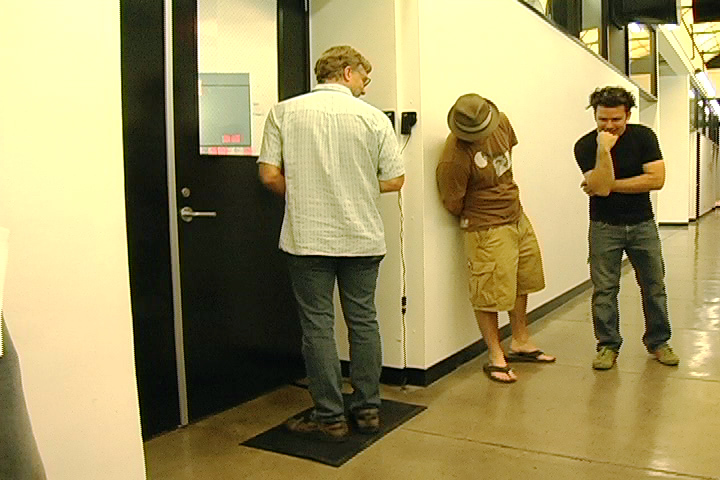Interaction: A Doormat with Attitude

"You certainly work hard." This Interactive Doormat affirms what professor Phil Van Allen already knows. Others weren't so lucky.
Assignment
Create an interactive system and code that has a personality with certain intentions, attitudes, inner thoughts, values and ideas. Your job as a designer is to create behaviors that reflect this personality and achieve the intentions and communications that the personality has. The personality does NOT need to be anthropormorphic or even "realistic." But the behavior should have a kind of coherency so that it makes sense to the user.
About the Project
In creating an Interactive Doormat, I wanted to explore the ways in which inanimate objects can create a feeling of judgement. What emerged however, was a rich understand of the connection between an interactive objects location, the locations perceived consciousness transmitted through voice, and the interaction that links the two together.
Location: In the final iteration, a doormat was placed in front of the Media Design department. Because speakers were used to project the voice of the doormat as well as its physical placement in the hallway, heightening interaction and making it more a public installation.
Voice:Iteration again was the key to developing a dynamic understanding of voice. On one hand, I had to decide if the interaction would best be suited by the use of one voice or the use of multiple voices. Functioning as a consciousness I felt the doormat was best served by one voice with dynamic personality.
This personality also had to serve a variety of purposes to reinforce a rich interaction. This included an understanding of the affordances of the physical object (Wipe your feet.) as well as its physical placement in transitions from inside to outside- and how that might influence the interaction (Did you turn off the coffee pot?).
Finally, the voice had to represent a dynamic personality that was consistent, able to surprise. An excellent example is the house cat that always purrs when you pet it, but that will occasionally swipe at your hand. Finally, the voice had to represent a consciousness and in turn, the voice of the unspoken conversation (Everyone thinks your work would improve if you were single).
How It Works
The Interactive Doormat works with a touch sensor, a make controller hooked to a laptop, a pair of speakers and a doormat. To activate the project, the user simply steps on the doormat (which is covering the touch sensor). By stepping on the doormat, the user tells the make controller/computer setup that the interaction is "on." Using Flash, the computer selects a sound bite, at random, from a folder of prerecorded sounds. (For the final project, there were over seventy statements recorded.) The selected sound is then transmitted through the speakers. To activate the doormat again, the user must step-off the doormat and step-on the doormat again.
Success
From the perspective of iteration and case study, I believe my decision to place the doormat outside the studio and use one voice (as opposed to multi-voice system) was a the correct one.
I also believe that I created enough content to provide a rich and complex interaction. During the critique only a handful of the over seventy comments were heard. Some of these comments were perceived as negative, to others they were funny. Yet was successful (and through no fault of my own) were the serendipitous moments when content and personality came together to give the perception that the doormat had some artificial intelligence.
Failures
My intention for this project was to develop an interactive object with personality. But what if nobody wants to interact with the project, in fact goes out of their way to interact with it.
Placed in a public space and heightened with speakers, the interaction became a public installation. Many of the users found the comments too negative- and broadcasting them to the public certainly didn't help (You've gained weight).
Personally, I felt that the sound wasn't loud enough. An increase in volume may have invited more people passing by to interact with the project. I do think the criticism that content was too negative was a valuable one and needs to be considered in future iterations. As Kylan pointed out, even though you may say ten nice things to someone, they will always remember the negative comment.
Lessons Learned
There were quite a few lessons gained from this project. Some were simply practical. I bought my materials early so that I was able to experiment with the content almost right away. These iterations lead to a rich understanding between voice and location.
What I failed to do was explore the interaction in its final location- almost before it was too late. On the day the project was due, I placed the doormat outside of the door and low and behold, the doormat was too large. What I did do, and was extremely smart, was to buy two doormats. I also bought two sensors, which came in handy when my first sensor "broke" moments later.
Testing the project in its final location would also have keyed me into the fact that radio waves (either from the key card, refrigerator, or whatever) had destroyed the communication between sensor and make controller- again moments before the final presentation.
Sampling of Voices
Inspired by the work of Jenny Holzer, there were over seventy different "voices" used in the final iteration. Here is a brief sampling of the phrases used:
Trust your instincts today.
Did you remember to turn off the coffee pot?
You've gained weight.
I'll have sex with you for 50 dollars.
Children 10 years or younger must be accompanied by an adult.
Why didn't you tip the coffee cart guy?
Everybody knows that you will succeed.
That shirt shows off your boobs.
Everybody knows your dating online.
Despite what they say, you are still a good person.